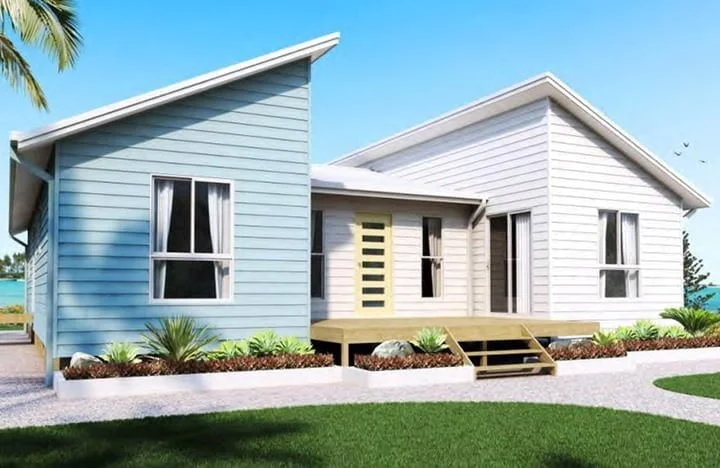Standard Ceiling Height
Why do we prefer high ceilings?
Usually, tall ceilings are one of the main selling points that any home seller will harp on when listing features of the house. For most of us, anything above the standard 2.4m ceiling is a big selling point. At iBuild, we help our clients extend the height of their kit homes. Read below for the costs that you can expect and extra information to consider when extending the height of your home:
Building Code of Australia
Our standard ceiling heights for kit homes and modular homes are all built in accordance with the NCC (National Construction Code) Building Code of Australia Volume 2. Within this code, section P2.4.2 relates to a performance provision that a building must meet regarding ceiling height. It states that the ceiling height of a room or space must not interfere with its intended use and purpose. The code also specifies specific minimums for rooms within a residence based on how the room is classified. The NCC breaks rooms down into two categories:
Habitable rooms, which includes:
bedrooms, living rooms, lounge rooms, music rooms, television rooms, kitchens, dining rooms, sewing rooms, studies, playrooms, family rooms, home theatres and sunrooms.
Non-habitable rooms, which includes:
bathrooms, laundries, water closets, pantries, walk-in wardrobes, corridors, hallways, garages and carports, photographic darkrooms, clothes-drying rooms, and other specialized spaces that are not exposed to frequent use for extended periods of time.
According to the NCC 2019 Building Code of Australia Volume 2, clause 3.8.2.2:
A habitable room must not have a ceiling height less than 2.4m, with the exception of a kitchen which must be no less than 2.1m. For habitable rooms that are accompanied with a sloped ceiling, the ceiling height must not be lower than 2.4m for at least two-thirds of the floor area within the room. As for non-habitable rooms, the ceiling height must be no less than 2.1m. For non-habitable rooms that also have a sloped ceiling, the ceiling height must not be lower than 2.1m for at least two-thirds of the floor area within the room.
Attics remain as one of the exceptions, as they must be no less than 2.2m over two-thirds of the floor area. The other being a room containing a stairway, ramp or landing which must be no less than 2.0m directly above the stair nosing lines, landings or ramp gradient.

Factors to consider when increasing your ceiling height
When increasing the size of a room, building upwards is always going to be more cost-effective than building outwards. By increasing the ceiling height, you are increasing the volume of a room without the significantly larger added cost of additional wall framing lengths, insulation, services, flooring, exterior and interior wall linings that come with increasing the floor area. Before making the decision to increase your ceiling height, it is worth considering the cost involved, the impact on the energy efficiency of your house along with the further design, and resale opportunities.
Construction Cost
Here at iBuild, we are often approached by customers that want to know how much it will cost them to increase the standard ceiling height of our Kit Homes from 2.4m to 2.7m. A calculation of the price would be highly dependent on your project needs and specifications, but on average the usual price increase is indicative of around 3% in total supply cost. This includes the added cost of higher frames, internal and external linings.
Energy Usage
One of the most important aspects of high ceilings worth considering is the impact it will have on your daily energy usage. Naturally, increasing the volume of a room is always going to increase the amount of energy used to heat the room. Due to the fact that hot air will rise, higher ceilings can be harder to keep warm during cold winters. Recent studies have shown that for every 10cm reduction in ceiling height, the energy consumption used for heating will be reduced by 1%. Having an increased room volume can also increase the cost associated with cooling a room with an air conditioning unit. Despite these drawbacks, these issues can easily be combated by paying closer attention to house design in order to take advantage of natural passive heating and cooling that could use less energy. Everything from installing ceiling fans, well-placed windows to allow for cool drafts and effective insulation can all assist in improving the energy efficiency of a home. For more information on design environmentally sustainable homes, visit http://www.yourhome.gov.au/.
Design and resale opportunity
It is also worth considering the impact that a ceiling height would have on the resale value of a home. Higher ceilings are generally more sought after by buyers in today’s property market. Psychological studies have shown that open rooms with high ceilings are more likely to be perceived as more aesthetically-pleasing, with lower ceilings provoking our brains to avoid space during the comparison. The higher vertical space allows for other options such as high doors, larger windows, and space for larger art pieces and décor within a home. Real estate companies have conducted research which suggests that increased ceiling heights will in fact increase a property’s value significantly.
The table below summarises the standard ceiling heights and upgrade options for various iBuild products.Show 102550100 entriesSearch:
| CEILING HEIGHT | 2.4M | 2.7M | 2.9M | RAKING FROM 2.4M TO 2.9M |
|---|---|---|---|---|
| Butterfly Modular Building | Central Section | Not available | Outer Section | Standard |
| InstantSlide Modular Building | Standard | Not available | Not available | Not available |
| Kit Homes | Standard | Optional upgrade | Optional upgrade | Optional upgrade – subject to design |
| Lekofly Modular Building | Standard | Optional Upgrade | Optional Upgrade | Not availalbe |
| TransPack Modular Building | Standard | Optional Upgrade | Optional Upgrade | Not available |
